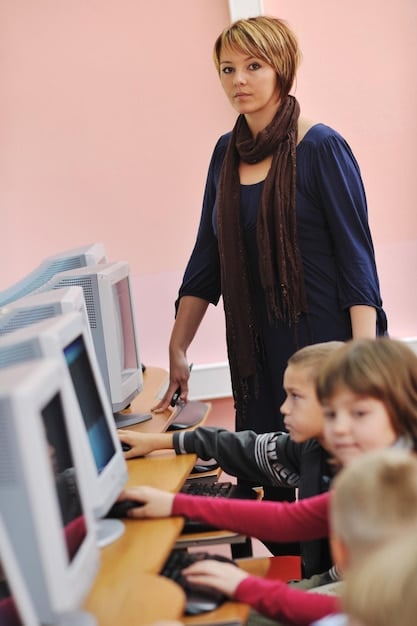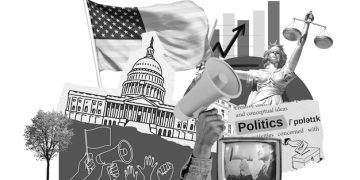Media Literacy Education: Fighting Misinformation in the Digital Age

Anúncios
Analyzing the role of media literacy education in combating misinformation reveals its crucial importance in equipping individuals with the skills to critically evaluate sources, understand media biases, and make informed decisions in a complex information landscape.
Anúncios
In an era defined by the rapid spread of information, discerning truth from falsehood has become an increasingly complex challenge. Analyzing the role of media literacy education in combating misinformation is paramount, equipping individuals with the critical thinking skills necessary to navigate the digital age.
Understanding Media Literacy Education
Media literacy education involves developing critical thinking skills that allow individuals to analyze, evaluate, and create media messages. It goes beyond simply being able to read and write; it empowers people to understand the underlying messages, biases, and intentions behind different forms of media.
Anúncios
Core Components of Media Literacy
Media literacy encompasses several key components that equip individuals with the tools to navigate the complex media landscape. These include critical thinking, analysis, evaluation, and content creation.
- Critical Thinking: The ability to question and evaluate information presented in the media.
- Analysis: Understanding how media messages are constructed and their potential impact.
- Evaluation: Assessing the credibility and reliability of media sources.
- Content Creation: Producing media messages responsibly and ethically.
These components work together to foster informed decision-making and responsible media consumption.
The Spread of Misinformation in the Digital Age
The digital age has brought unprecedented access to information, but it has also created fertile ground for the proliferation of misinformation. Social media platforms, in particular, have become breeding grounds for fake news and propaganda, often spread through algorithms that prioritize engagement over accuracy.

Mechanisms of Misinformation
Understanding how misinformation spreads is crucial for combating its influence. Several mechanisms contribute to its rapid and widespread dissemination.
- Social Media Algorithms: These algorithms often prioritize engagement, leading to the amplification of sensational or emotionally charged content, regardless of its accuracy.
- Echo Chambers: Online communities where individuals are primarily exposed to information that confirms their existing beliefs, reinforcing biases and limiting exposure to diverse perspectives.
- Bots and Fake Accounts: Automated accounts designed to spread misinformation and manipulate public opinion.
These mechanisms create a complex web of disinformation that can be difficult to untangle.
How Media Literacy Education Combats Misinformation
Media literacy education directly addresses the mechanisms through which misinformation spreads by equipping individuals with the skills to critically evaluate information and identify biases. By fostering critical thinking, media literacy empowers people to become more discerning consumers of media.
Enhancing Critical Thinking
Critical thinking is at the heart of media literacy education. It involves teaching individuals how to question sources, analyze motives, and evaluate evidence before accepting information as fact.
By developing these skills, individuals are better equipped to resist the influence of misinformation and make informed decisions based on reliable evidence.
The Role of Educational Institutions
Educational institutions play a pivotal role in promoting media literacy. Integrating media literacy into curricula at all levels can ensure that students develop the skills they need to navigate the complex media landscape.

Curriculum Integration
Integrating media literacy into existing curricula can be achieved through various methods, including lesson plans, workshops, and collaborative projects.
- Lesson Plans: Developing specific lesson plans that focus on analyzing news articles, identifying biases, and evaluating sources.
- Workshops: Conducting workshops that provide hands-on experience in creating and analyzing media messages.
- Collaborative Projects: Encouraging students to work together on projects that require them to critically evaluate and create media content.
By integrating media literacy into the curriculum, educators can ensure that students develop these crucial skills.
The Importance of Community Engagement
Media literacy education is not limited to the classroom; it also requires community engagement. Libraries, community centers, and other local organizations can play a crucial role in providing media literacy resources and workshops to the broader community.
Community Workshops and Resources
Offering workshops and providing access to resources can empower community members to become more media literate.
These initiatives can help to create a more informed and engaged citizenry.
Challenges and Future Directions
Despite its importance, media literacy education faces several challenges, including a lack of funding, standardized curricula, and teacher training. Addressing these challenges is essential for ensuring that media literacy education is accessible and effective for all.
Addressing the Challenges
Overcoming these challenges requires a multi-faceted approach that involves government support, curriculum development, and teacher training.
- Government Support: Investing in media literacy education through funding and policy initiatives.
- Curriculum Development: Developing standardized curricula that align with best practices and address the evolving media landscape.
- Teacher Training: Providing teachers with the training and resources they need to effectively teach media literacy.
By addressing these challenges, we can ensure that media literacy education reaches its full potential.
| Key Point 💡 | Brief Description |
|---|---|
| 📚 Core Skills | Critical thinking, analysis, and evaluation of media. |
| 🌐 Digital Spread | Social media and algorithms amplify misinformation. |
| 🏫 Education Role | Integration into curricula and community workshops. |
| 🔑 Challenges | Funding, standardized curricula, and teacher training. |
Frequently Asked Questions
▼
Media literacy education involves developing critical thinking skills to analyze, evaluate, and create media messages. It empowers individuals to understand biases and intentions behind media content.
▼
It is crucial for combating misinformation by equipping individuals with the skills to discern truth from falsehood and make informed decisions in the digital age, promoting a more informed society.
▼
Misinformation spreads through social media algorithms, echo chambers, bots, and fake accounts, which prioritize engagement over accuracy and reinforce existing beliefs, leading to widespread dissemination.
▼
They play a pivotal role by integrating media literacy into curricula, offering lesson plans and workshops, and encouraging collaborative projects that enhance critical thinking and responsible media consumption.
▼
Future directions involve addressing challenges like lack of funding, standardized curricula, and teacher training through government support, curriculum development, and providing teachers with necessary resources.
Conclusion
In conclusion, analyzing the role of media literacy education in combating misinformation underscores its vital function in today’s digital society. By fostering critical thinking and responsible media consumption, it empowers individuals to navigate the complex information landscape and make informed decisions. Continued investment and integration of media literacy education are essential for building a more resilient and informed citizenry.





